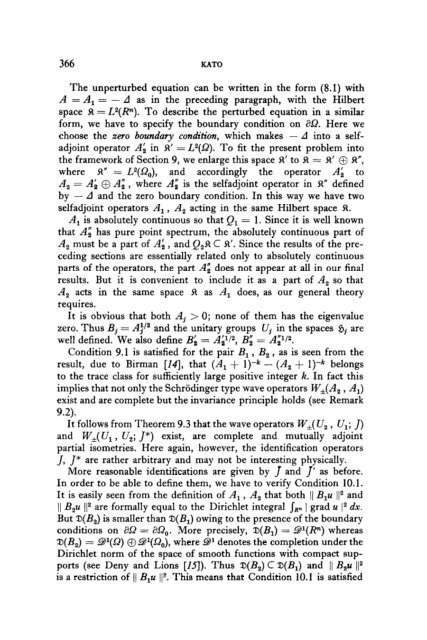On the Characters and the Plancherel Formula of Nilpotent Groups ...
On the Characters and the Plancherel Formula of Nilpotent Groups ...
On the Characters and the Plancherel Formula of Nilpotent Groups ...
You also want an ePaper? Increase the reach of your titles
YUMPU automatically turns print PDFs into web optimized ePapers that Google loves.
366 KATO<br />
The unperturbed equation can be written in <strong>the</strong> form (8.1) with<br />
A = A, = - d as in <strong>the</strong> preceding paragraph, with <strong>the</strong> Hilbert<br />
space R = L2(Rlt). To describe <strong>the</strong> perturbed equation in a similar<br />
form, we have to specify <strong>the</strong> boundary condition on X! Here we<br />
choose <strong>the</strong> zero boundary condition, which makes - A into a selfadjoint<br />
operator A; in R’ = L2(s2). To fit <strong>the</strong> present problem into<br />
<strong>the</strong> framework <strong>of</strong> Section 9, we enlarge this space a’ to R = R’ @ R”,<br />
where R” = L2(ln,), <strong>and</strong> accordingly <strong>the</strong> operator Ai to<br />
A,=A;l@Ai, where A,” is <strong>the</strong> selfadjoint operator in s” defined<br />
by - A <strong>and</strong> <strong>the</strong> zero boundary condition. In this way we have two<br />
selfadjoint operators A, , A, acting in <strong>the</strong> same Hilbert space R.<br />
A, is absolutely continuous so that Qr = 1. Since it is well known<br />
that Ai has pure point spectrum, <strong>the</strong> absolutely continuous part <strong>of</strong><br />
A, must be a part <strong>of</strong> A;1 , <strong>and</strong> Q2R C a’. Since <strong>the</strong> results <strong>of</strong> <strong>the</strong> preceding<br />
sections are essentially related only to absolutely continuous<br />
parts <strong>of</strong> <strong>the</strong> operators, <strong>the</strong> part Ai does not appear at all in our final<br />
results. But it is convenient to include it as a part <strong>of</strong> A, so that<br />
A, acts in <strong>the</strong> same space fi as A, does, as our general <strong>the</strong>ory<br />
requires.<br />
It is obvious that both A, > 0; none <strong>of</strong> <strong>the</strong>m has <strong>the</strong> eigenvalue<br />
zero. Thus Bi = Aila <strong>and</strong> <strong>the</strong> unitary groups Uj in <strong>the</strong> spaces 81 are<br />
well defined. We also define Bk = Ai1J2, B,” = Ai112.<br />
Condition 9.1 is satisfied for <strong>the</strong> pair B, , B, , as is seen from <strong>the</strong><br />
result, due to Birman [14], that (A, + 1)-k - (A, + 1)-k belongs<br />
to <strong>the</strong> trace class for sufficiently large positive integer k. In fact this<br />
implies that not only <strong>the</strong> Schrodinger type wave operators W,(A, , A,)<br />
exist <strong>and</strong> are complete but <strong>the</strong> invariance principle holds (see Remark<br />
9.2).<br />
It follows from Theorem 9.3 that <strong>the</strong> wave operators W,( U, , U1; J)<br />
<strong>and</strong> W,( Ul , U2; J*) exist, are complete <strong>and</strong> mutually adjoint<br />
partial isometries. Here again, however, <strong>the</strong> identification operators<br />
J, J* are ra<strong>the</strong>r arbitrary <strong>and</strong> may not be interesting physically.<br />
More reasonable identifications are given by J <strong>and</strong> J’ as before.<br />
In order to be able to define <strong>the</strong>m, we have to verify Condition 10.1.<br />
It is easily seen from <strong>the</strong> definition <strong>of</strong> A, , A, that both I] B,u II2 <strong>and</strong><br />
11 B,u ]I2 are formally equal to <strong>the</strong> Dirichlet integral JR” I grad u I2 dx.<br />
But a(B,) is smaller than D(B,) owing to <strong>the</strong> presence <strong>of</strong> <strong>the</strong> boundary<br />
conditions on 8JJ = 2X$,. More precisely, D(B,) = 5@(P) whereas<br />
?D(B,) = P(G) @ .W(52,), where @ denotes <strong>the</strong> completion under <strong>the</strong><br />
Dirichlet norm <strong>of</strong> <strong>the</strong> space <strong>of</strong> smooth functions with compact supports<br />
(see Deny <strong>and</strong> Lions [15]). Thus ~~(23,) C D(B,) <strong>and</strong> 11 B,u ]I2<br />
is a restriction <strong>of</strong> )I B,u l12. This means that Condition 10.1 is satisfied

















